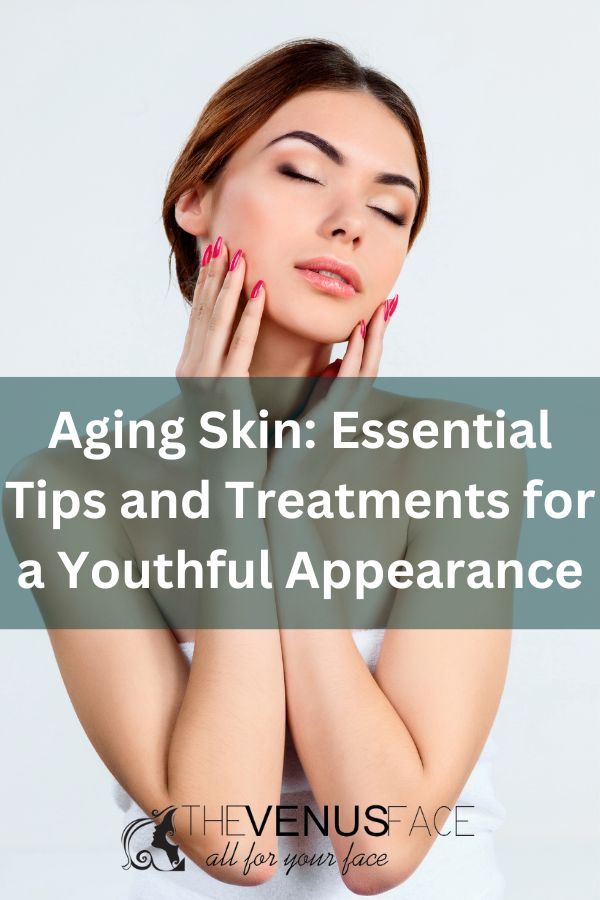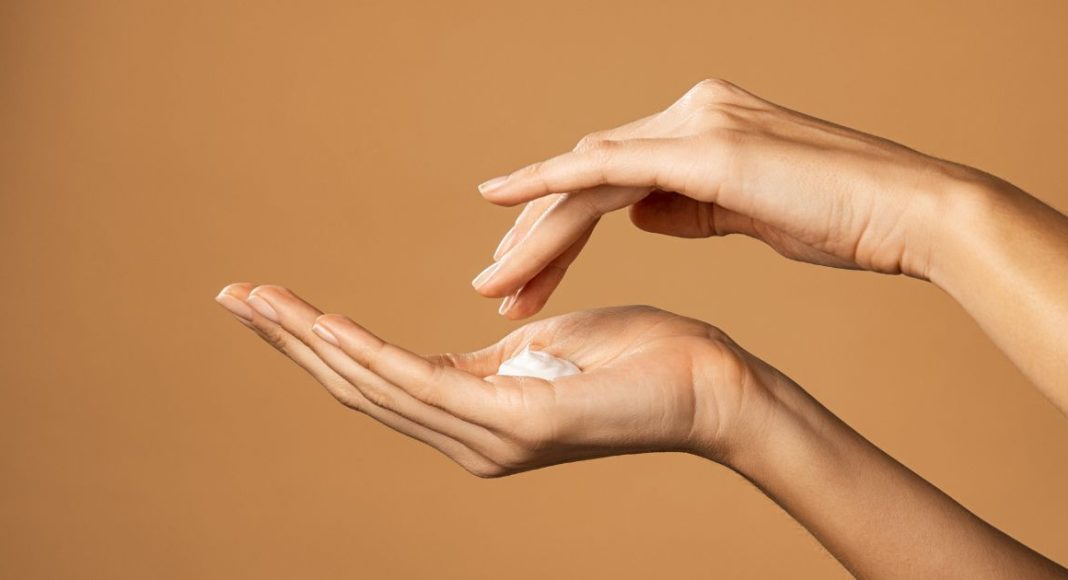This article will discuss skincare tips and cosmetic treatments that can help support healthy skin over time.

Build A Skincare Routine
Building a skincare routine and investing time daily to keep up with it is a simple but effective way to keep your skin looking and feeling vibrant and healthy. It typically takes upwards of six weeks of consistently using a product daily before you begin to see results. You should always apply skincare products in order of consistency, from thinnest to thickest.
A basic skincare routine is comprised of five steps:
- Cleansing
- Toning
- Treating with serums
- Moisturizing
- Protecting with sunscreen
Cleansing
Washing your face is the first step to achieving healthy skin. Washing your face twice daily – once in the morning and once at night will help you avoid acne, clogged pores, and dullness.
The type of cleanser you should use depends on your skin type. Generally, you should only use exfoliating scrubs once a week and stay away from products made with crushed walnut shells or abrasive ingredients.
- For dry, red, or eczema-prone skin: cream or lotion (wipes away impurities and hydrates the skin)
- For oily or acne-prone skin: foaming liquid (helps dissolve dirt and excess sebum from pores)
Toning
Toners have come a long way from the original alcohol-based products that remove excess oil and any leftover dirt after cleansing. Today’s toners provide additional nutrients, help your other skincare products absorb better, and balance your complexion.
If you use a toner, apply it after your cleanser and before using other skin products. You can apply toner with clean hands or with a stretched-out cotton ball. Most toners can be used morning and evening.
Here are some ingredients to look for when trying to choose a toner:
- Alpha and beta hydroxy acids improve sun-damaged skin, minimize dullness, and gently remove dead skin cells that can clog pores.
- Hyaluronic acid subtly treats fine lines by boosting hydration, sealing in dewiness, and plumping the skin.
- Green tea and rose water soothe irritation and reduce redness with an anti-inflammatory effect.
- Vitamins C and E fight free radicals that can age your skin.
Treating With Serums
Serums contain concentrated doses of active ingredients that can help manage several skin issues, from dark circles to wrinkles. However, even those without specific skin issues to target can rely on a general antioxidant serum each morning to protect their skin.
Different serum ingredients target various issues, such as:
- Colloidal sulfur and niacinamide have antimicrobial effects that improve acne and reduce irritation and redness by decreasing inflammation.
- Hyaluronic acid seals hydration and strengthens the barrier function of the top layer of your skin to prevent moisture loss.
- Retinol, vitamin B3, and peptides stimulate the production of elastin and collagen, proteins that help prevent lines and skin from sagging.
- Vitamin C helps brighten dull skin and reduce dark spots with consistent use.
You can use multiple serums to target concerns, but you should ask your dermatologist about combining specific products. Do not mix a serum with your moisturizer, which will diminish the serum’s absorption ability. Instead, apply products one at a time.
How often you must apply the serum will vary based on the ingredients. For example, antioxidant serums are best in the morning, but retinol is applied at night because it can degrade in the sun. When in doubt, consult the label instructions to determine when and how often to use a particular serum.
Moisturizing
Moisturizers hydrate and soften your skin and should be a part of your year-round regimen, regardless of skin type.
Different skin types need different textures of moisturizer:
- For dry skin: cream and soft cream
- For inflamed and sensitive skin that is not acne-prone: balm
- For normal or combination skin: lotion
Some creams are for daily use, and others are applied at night. Many day creams contain antioxidants and are typically lighter in consistency. Night creams use ingredients like retinol to speed cellular turnover and treat dark spots. They tend to have a rich, thick texture.
Eye creams are not necessary, but they can treat issues like dryness, hyperpigmentation, and puffiness. Caffeine, hyaluronic acid, and peptides can soothe under-eye bags and inflammation. Other ingredients to look for in an eye cream include kojic acid, niacinamide, and vitamin C, which can help brighten your skin. Avoid eye creams that contain potent retinol and fragrance, which can irritate your eyes.
Protecting With Sunscreen
Sunscreen is the most crucial skincare product. Consistently using sunscreen daily protects your skin from forming fine lines and wrinkles and even reduces your risk of developing skin cancer. You can use a daily moisturizer with a built-in broad-spectrum sun protection factor (SPF) of 30 or higher.
There are two types of ingredients in sunscreen products:
- Chemical ingredients such as octinoxate and oxybenzone, which are absorbed into your skin to fight damage from ultraviolet light
- Physical ingredients like titanium dioxide and zinc oxide sit on the surface of your skin, deflecting UV rays from entering your body.
You should apply sunscreen 30 minutes before exposure to the sun and reapply at least every two hours. You should use about two tablespoons of sunscreen to cover your face and exposed body areas. Use a nickel-sized amount on your face and the rest on your body.
NAD IV Treatment
Nicotinamide adenine dinucleotide (NAD) is a coenzyme that boosts metabolism, maintains mitochondrial function, and supports cellular health.
NAD IV therapy in San Diego and other cities deliver NAD directly into your bloodstream, providing faster and more complete results than oral NAD supplements that must go through your digestive system before they can begin working.
Cosmetic Treatments
You can use several cosmetic treatments to improve the health and appearance of your skin, such as Botox, chemical peels, and microneedling.
Botox
Botox is a prescription injectable medication created from the botulinum toxin. These purified bacteria temporarily immobilize the muscles that make crow’s feet and age lines by prompting nerves to stop sending signals for muscles to contract.
The results of Botox injections can provide months of reduced crow’s feet and forehead lines.
Chemical Peels
A chemical peel is a liquid chemical solution that peels off the surface layer of your skin, revealing a fresh layer of healthy, smooth skin. It is best to have a chemical peel done by a professional who can examine your skin and recommend the best type of chemical peel for your skin type. Remove any makeup you may have on and prep your skin before starting the chemical peel.
The process is simple: the solution sits on your face for a few minutes. You can expect a stinging feeling, dryness, redness, slight swelling, and peeling or flaking during and after the treatment, a signal the chemical peel is working. The appointment should take 30 minutes to an hour.
There are three different strengths, and your recovery time depends on the type of peel you get. Light peels are easy on your skin, and recovery time is short. If you get a medium or deep peel, your skin may take a few weeks to return to normal.
Microneedling
Microneedling, or collagen induction therapy (CIT), is a minimally-invasive procedure a skincare professional performs. A small handheld device creates micro-injuries to rejuvenate your skin. Microneedling improves skin firmness and texture and diminishes pore size, scars, and stretch marks. Microneedling can be used on all areas of your body, even the sensitive skin around your eyes.
There are many ways to administer microneedling, including dermal rollers, dermal stamps, and mechanical microneedling pens.
Last Words
Skin inevitably loses elasticity as you age, but you can do several things to improve your skin’s health and appearance. Building a skincare routine that involves daily use of cleansers, toners, serums, moisturizers, and sunscreen should be your first defense against skin issues.
You can use NAD IV or cosmetic treatments like Botox injections, chemical peels, and microneedling for more stubborn or harder-to-treat issues like fine lines and acne scars. Consult your doctor to determine which treatment option best suits your lifestyle.


